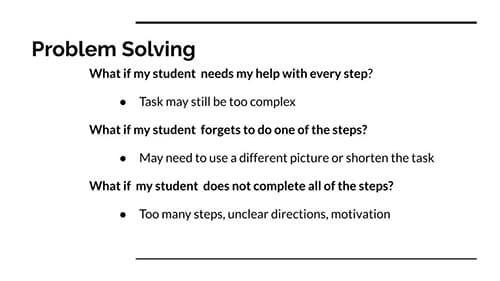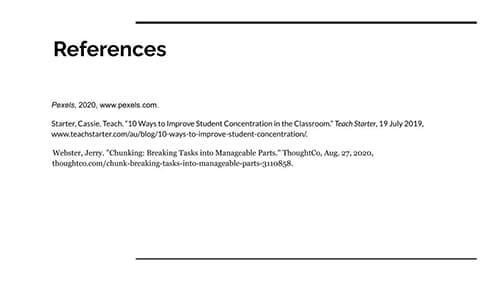Breaking Down a Task
Transcript

Title
This Behavior Talks module is about Breaking Down a Task
About Behavior Talks
The Behavior Talks modules are a series of brief trainings created by HCPSS team members. Each module shares useful tips and tricks to promote student success related to behavior, social/emotional needs, or organization/self-management.
Behavior is a form of communication. Understanding why a behavior is happening helps determine strategies to prevent or reduce the recurrence of challenging behavior. Figuring out “the why” will help determine responses to teach alternative behaviors and skills. Let’s Talk About (Breaking Down A Task)!

Outcomes
By the end of this module, parents and caregivers will be able identify and be provided strategies on breaking up more complex tasks into more manageable steps.
- Identify Tasks or Routines which require multiple steps
- Identify Manageable steps to be completed and
- Identify different Ways to Break down a Task

Breaking Down a Task
Let’s Talk About Breaking Down a Task.
Breaking Down a Task…
Breaking down a task is a strategy that will help your student manage complex tasks. This strategy breaks a larger task or project into smaller, manageable steps. Consider the many small steps you take to brush your teeth. You may wet your brush, apply toothpaste, brush your teeth, rinse your mouth and toothbrush, and floss. We can help students be more successful in completing multi-step tasks by focusing on one step at time. Examples of complex tasks might include getting ready for school, completing a science project, writing a multi-paragraph essay, or managing a busy day. The complexity of a task depends on your student’s age, abilities, and personal preferences.
Breaking Down a Task into Smaller Steps Helps Make Directions
When a task is too overwhelming students may display behaviors such as work avoidance, forgetfulness, or frequent tantrums. Breaking a task into smaller parts has many benefits and often improves these challenging behaviors. This strategy makes larger tasks less daunting by helping your student to see a beginning and end to a task. Breaking a task into smaller manageable steps encourages organization, steady progress, and independence.
Examples
Here are some examples of a task broken down. Depending on the student, the task can be in the form of a picture, in words or a combination of both. Many times a student may need some individualized motivation or reward to complete all the steps. For example, the Saturday tasks have a reward identified when the checklist is complete. In the bedtime routine example the tasks are hand drawn pictures. The bedtime story is the reward or motivator for getting ready for bed. It’s important to note not all students may require rewards to complete the tasks.
Examples: School Related Tasks
Here are two examples that are school related. In the example, “Getting ready for school”, the student could check off each completed task. The caregiver or teacher could check it off as well, or insert a “smiley face”, or some other motivating sticker.
The student could also cross off each completed item as in the “Reading assignment” example. Note that in this example, easy tasks such as taking a stretch is listed between tasks requiring work; this breaks up multiple work tasks chunked together, which could be overwhelming.

Think Abouts
If you are teaching a new skill or have a new expectation for independence, you want to consider how many steps you think your student can handle. As you can see in the chart, the average concentration span for a student can vary. The routine of getting dressed includes so many more steps than putting clothes on. Will you have your student pick out what to wear? Can they handle fasteners? Will they put it on in the right order? Another consideration is how long should this take? If a task should be 5 minutes at most, you may want to check in on them at 3-minutes to ensure that they are on track. Another consideration is how you should teach this skill. When teaching a new skill to your student you may need to show them how to complete the task first. You may need to do the task with them, or watch them do the entire routine before you allow them to do the routine without supervision. If your student is having trouble with a task you may want to try more pictures. For example, you may want to use numbers to assist a student who has trouble knowing what step comes next.
Problem Solving
Based on how your student completed each step, you may need to adjust your expectation of the task. For example, if your student requires help for each step, the task may be too complex. In these cases, we may need to break the task into even smaller steps. If your student is skipping steps or not finishing the routine, start by reviewing the tasks with them and remind them of the correct order. You may also want to consider picture examples of the steps, you could show your student how to do the step, or complete the step with them.
References
Pexels, 2020, www.pexels.com.
Starter, Cassie. Teach. “10 Ways to Improve Student Concentration in the Classroom.” Teach Starter, 19 July 2019, www.teachstarter.com/au/blog/10-ways-to-improve-student-concentration/.
Webster, Jerry. “Chunking: Breaking Tasks into Manageable Parts.” ThoughtCo, Aug. 27, 2020, thoughtco.com/chunk-breaking-tasks-into-manageable-parts-3110858.
